Michael Salomone/Courtesy photo
The local rivers are holding some incredible fly fishing between their banks. Anglers looking to maximize their time on the water are resorting to fishing with dry dropper rigs and for good reasons. Fly fishing with your bugs rigged in a dry dropper style catches fish on top of and underneath the water.
A dry dropper rig presents a dry fly on the surface and a nymph under the water. A trailing piece of tippet is attached to the dry fly and a nymph fly is tied to the end of the tippet. The dry fly represents an adult insect. The nymph imitates a larva, pupae or emerger stage in an insect’s development. Two different stages of one insect. Or two completely different insects offered at a variety of levels in the water column.

Michael Salomone/Courtesy photo
Anglers looking to explore the positive attributes of dry droppers will want to choose a dry fly with enough body to support a piece of tippet and attached nymph. Chubby Chernobyl flies have a large foam body capable of supporting heavy beaded nymphs. Chubbies are highly visible and as summer progresses illicit smashing surface strikes.
Another good surface choice would be a large Parachute Madame X or PMX. This fly has flexible rubber legs, a slender silhouette and broad white parachute for increased visibility. And it holds up a sizable dropper.
Nymphs can cover a huge spectrum, from miniscule larva to active emerger imitations. Heavy beaded, jig-hook nymphs ride deep and draw strikes when other nymphs ride too shallow. Soft hackle nymphs breathe in the water when fished behind a bushy, caddis or fuzzy stimi and benefit from a little prolonged wait at the end of a drift before casting again. The wait allows the soft hackle fly to rise toward the surface like a naturally emerging insect.
The tungsten beaded, jig hook nymphs ride with the point up to prevent snagging. These flies are always tied barbless so the importance of maintaining control during the battle with a fish is elevated. The hooks are ultra sharp which more than makes up for the lack of a barb.
Tippet length is a variable that every angler can experiment with. Short lengths of tippet in the foot to foot and a half-length can be fished extremely shallow behind a smaller dry fly. Long lengths of tippet and a dropper require the support of a Chubby Chernobyl or similar fly. Some anglers go as far as to use droppers in the three to four-foot range. Care needs to be exercised when casting a long dopper.
Targeting the depth change off the bank is a productive zone for a dry dropper rig. The transition from shallow to deep water is often an underwater stair-step structure that holds numbers of fish. Drifting a dry dropper rig along this feeding lane will keep your net wet. A good oarsman will be able to extend your effective drift in this type of situation.
Large eddies create foam lines where the main current crashes against the recirculating water. The foam lines are the feeding lanes to exploit with a dry dropper rig, As the day progresses anglers can utilize spent wing spinners, or dead bugs as the dropper. This dropper won’t ride very deep but is good for the foam.

Michael Salomone/Courtesy photo
Confluences are good places to fish a dry dropper rig. With the incoming water, small nymphs are dislodged and washed into the main river current. Fish will key in on any high floating dry fly that washes down the feeder creek.
Effective dry dropper rigs could be as simple as two stages of the same insect. This can be represented by an Elk Hair Caddis dry fly and a X-caddis dropper. Foam hopper dry fly followed by a heavy jig hook nymph covers extreme depths as far as dry dropper rigs go. And a Chubby Chernobyl paired up with just about any nymph as a dropper is going to be effective. Two different stages in a bug’s life as well as two different insects, dry dropper fly fishing produces on the top or underneath.
Michael Salomone moved to the Eagle River valley in 1992. He began guiding fly-fishing professionally in 2002. His freelance writing has been published in magazines and websites including, Southwest Fly Fishing, Fly Rod & Reel, Eastern Fly Fishing, On the Fly, FlyLords, the Pointing Dog Journal, Upland Almanac, the Echo website, Vail Valley Anglers and more. He lives on the bank of the Eagle River with his wife, Lori; two daughters, Emily and Ella; and a brace of yellow Labrador retrievers.
Credit: Source link































